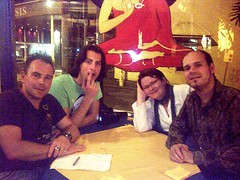 At the Creative Places + Spaces conference in Toronto last year, I met a couple of colleagues from Breda University in the Netherlands, who run a number of creative industries-related courses - but in a leisure management context, which is quite different from the approach we're taking at QUT, but also includes exciting new concepts such as ' imagineering'. This week, Peter Horsten and Arend Hardorff are in Brisbane to visit QUT as well as a number of other local organisations (such as Michael Doneman's Edgeware) and explore opportunities for further collaboration. Last night, Ann and I took them out for dinner at the Tibetan Kitchen, and ended up chatting until the restaurant staff had to tell us in no uncertain terms 'we're closing now'. Let's hope we can maintain the connection - good to see you again, guys...
At the Creative Places + Spaces conference in Toronto last year, I met a couple of colleagues from Breda University in the Netherlands, who run a number of creative industries-related courses - but in a leisure management context, which is quite different from the approach we're taking at QUT, but also includes exciting new concepts such as ' imagineering'. This week, Peter Horsten and Arend Hardorff are in Brisbane to visit QUT as well as a number of other local organisations (such as Michael Doneman's Edgeware) and explore opportunities for further collaboration. Last night, Ann and I took them out for dinner at the Tibetan Kitchen, and ended up chatting until the restaurant staff had to tell us in no uncertain terms 'we're closing now'. Let's hope we can maintain the connection - good to see you again, guys...












